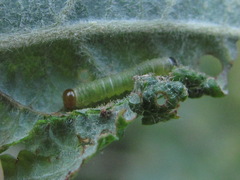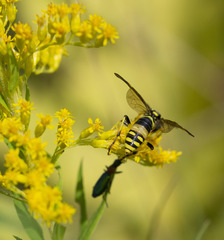Symphyta: taxon details and analytics
- Domain
- Kingdom
- Animalia
- Phylum
- Arthropoda
- Class
- Insecta
- Order
- Hymenoptera
- Family
- Genus
- Species
- Scientific Name
- Symphyta
Summary description from Wikipedia:
Sawfly
Sawflies are wasp-like insects that are in the suborder Symphyta within the order Hymenoptera. The common name comes from the saw-like appearance of the ovipositor, which the females use to cut into the plants where they lay their eggs. The name is associated especially with the Tenthredinoidea, by far the largest superfamily in the suborder, with about 7,000 known species; in the entire suborder, there are 8,000 described species in more than 800 genera.
Despite their given taxonomic rank of suborder, Symphyta is a paraphyletic group, consisting of several basal groups within the order Hymenoptera, with each one rooted inside the previous group; the various superfamilies of insects called "sawfly" do form a natural group or clade, but this clade also includes the Apocrita — the ants, bees, and wasps — which are not considered sawflies. The primary distinction between sawflies and the Apocrita is that the adult sawflies (the imago) lack a "wasp waist" or petiole; the segments connecting the abdomen and the thorax smoothly transition between the two (leading to their scientific name). Sawflies first appeared 250 million years ago in the Triassic. The oldest superfamily, the Xyeloidea, is still extant today. Over 200 million years ago, a lineage of sawflies evolved a parasitoid lifestyle, with carnivorous larvae that ate the eggs or larvae of other insects. Sawflies are distributed globally, though they are more diverse in the northernmost hemispheres.
Some sawflies are Batesian mimics of wasps and bees, and the ovipositor can be mistaken for a stinger. Sawflies vary in length, most measuring 2.5 to 20 millimetres (3⁄32 to 25⁄32 in); the largest known sawfly measured 55 mm (2+1⁄4 in). The great majority of sawflies are herbivorous, though the members of the superfamily Orussoidea are parasitoids. Their own predators include birds, small mammals such as shrews, and other insects, such as Dipterans and other Hymenopterans, which themselves may be parasitoids of sawflies. The larvae of some species have anti-predator adaptations such as regurgitating irritating liquid and clustering together for safety in numbers.
The herbivorous larvae are often confused with caterpillars, but can be distinguished from these by the number of prolegs and the absence of crochets. Sawflies go through a complete metamorphosis with four distinct life stages – egg, larva, pupa and adult. Adult sawflies are short-lived, with a life expectancy of 7–9 days, though the larval stage can last from months to years, depending on the species. Parthenogenetic females, which do not need to mate to produce fertilised eggs, are common in the suborder, though many species have males and practice sexual reproduction. The adults feed on pollen, nectar, honeydew, sap, other insects, including hemolymph of the larvae hosts; they have mouth pieces adapted to these types of feeding. The female uses her ovipositor to drill into plant material (or, in the case of Orussoidea, other insects) and then lays eggs in groups called rafts or pods. As the larvae approach adulthood, they seek a protected spot to pupate, typically in bark or the soil.
Large populations of species such as the pine sawfly can cause substantial damage to economic forestry, while others such as the iris sawfly are major pests in horticulture. Outbreaks of sawfly larvae can defoliate trees and may cause dieback, stunting or death. Sawflies can be controlled through the use of insecticides, natural predators and parasitoids, or mechanical methods.
...Symphyta in languages:
- Bokmål
- plantevepser
- Bulgarian
- Растителноядни оси
- Chinese
- 廣腰亞目
- Czech
- širopasí
- Danish
- Savhvepse
- Dutch
- Bladwespen
- English
- Sawflies, Horntails, and Wood Wasps
- English
- Sawfly
- Estonian
- Pidevkehalised
- Finnish
- Sahapistiäiset
- French
- Symphytes
- German
- Pflanzenwespen
- German
- Sägewespen
- Hebrew
- אל-שנציים
- Hungarian
- növényevő darazsak
- Italian
- Sinfiti
- Japanese
- ハバチ亜目
- Japanese
- 広腰亜目
- Korean
- 잎벌아목
- Lithuanian
- Liemenpilviai
- Modern Greek
- Σύμφυτα
- Polish
- Rośliniarki
- Portuguese
- Vespas-porta-serra
- Russian
- Сидячебрюхие
- Swedish
- växtsteklar
Images from inaturalist.org observations:
We recommend you sign up for this excellent, free service.
Parent Taxon
Sibling Taxa
Top Observation Places
- Ostankinskiy
- Greater Sudbury
- Nanterre
- Colombes
- Rueil-Malmaison
- Towson
- Basel
- Aliso Viejo
- West Hartford
- Oldenburg
- Kiel
- Carson
- McAllen
- Helsinki
- Union
- Lausanne
- Islington
- Archway
- Temuco
- Turku
- Offenburg
- Toulouse
- Wheaton
- Davis
- Anchorage
- San José
- Charlottenburg
- Freiburg
- Veenendaal
- Dormagen
- Saskatoon
- Salford
- Delta
- New Westminster
- Windsor
- Santa Cruz
- San Antonio
- Zheleznogorsk
- Glasgow
- Gainesville
- Lyon 09
- Redlands
- Korolev
- Babushkin
- Tlalpan
- Xochimilco
- Bristol
- Hamilton
- Bergamo
- Nottingham































































































































































